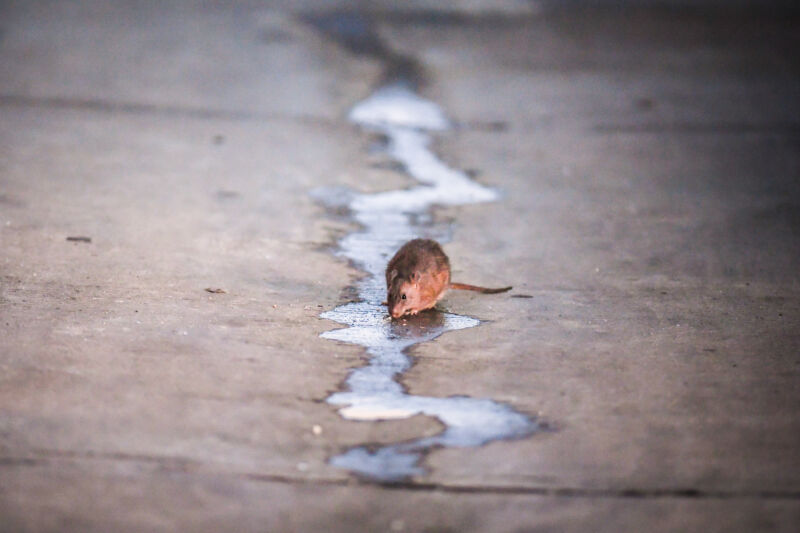
/ A rat drinks water in a back alley in the Park View neighborhood near a construction site on Saturday, September 10, 2017, in Washington, D.C.
Many people might already think of the nation’s capital as a political rat’s nest, teeming with rat-related features, like underground networks and crowded backrooms where any faint smell of betrayal could send lawmakers scurrying. But Washington, DC, is also a den of literal rats. And it’s creating a concerning risk of viral spillover for residents.
In a report released Thursday by the Centers for Disease Control and Prevention, DC health officials ratted out the first two known cases of hantavirus spillover in the city. The virus festers quietly in rats and other rodent populations, but in humans it can cause potentially deadly respiratory and hemorrhagic diseases. Humans pick up the infection by direct contact with rodent urine or nest dust or by breathing in aerosolized viral particles from urine, droppings, or saliva. There’s also the possibility that the virus can spread from rat bites, but this is less common. Once in a human, the virus almost never jumps from human to human.
Fortunately for DC residents, the type of hantavirus found in the city is one of the milder types: an “Old World” hantavirus called the Seoul virus. Old World hantaviruses cause a disease called Hemorrhagic fever with renal syndrome. HFRS can start out like a generic infection with fever, chills, nausea, and headache. But it can progress to low blood pressure, acute shock, vascular leakage, and acute kidney failure, the CDC notes. The severity of HFRS varies by which hantavirus you catch, but fatality rates can reach up to 15 percent. The Seoul virus is one of the milder forms, with a fatality rate of only about 1 percent. As such, in both of the cases reported by DC health officials, the infected individuals recovered.
Two hantaviruses
That’s a relatively rosy scenario. The Americas are best known for harboring “New World” hantaviruses, which cause a severe respiratory disease called Hantavirus Pulmonary Syndrome. And these are much more deadly. HPS can also begin like a generic infection, with fever, chills, and aches. But, it can progress to an acute, life-threatening cardiopulmonary phase after about a week. And from there, the disease can progress rapidly, with the lungs filling with fluid and people needing hospitalization and often ventilation within 24 hours. HPS is fatal in about 38 percent of cases, the CDC notes. But for the most important “New World” hantavirus in the US—the Sin Nombre virus, spread by the deer mouse—the fatality rate is about 50 percent.
Sin Nombre and HPS first came to the attention of US health officials in 1993, following a mysterious outbreak of deadly respiratory illnesses in the Four Corners region, where Arizona, Colorado, New Mexico, and Utah meet. CDC disease investigators raced to understand the never-before-seen virus, dubbed Sin Nombre (the virus with no name), while capturing and testing hundreds of area rodents to find the source. In all, the CDC identified 48 cases in 1993, 27 of which were fatal. Between that first outbreak in 1993 and 2019, the CDC’s official tally of hantavirus infections has reached 816.
The Seoul virus, Sin Nombre’s milder cousin, has had a much lower-key presence in the US. Seoul spreads among and from the common brown rat—sometimes called a sewer rat, wharf rat, or Norway rat. These rats have traveled extensively on ships through the ages, making homes worldwide, particularly in urban environments. They’re also kept as pets. With the rat’s global distribution, the Seoul virus is also found worldwide, though it was first described in Korea, hence the name.
Seoul virus has been found lurking in the wild rodent populations of several US cities, including Baltimore and New Orleans. It has also been found in pet rats throughout the country. A 2017 investigation by US and Canadian health officials identified 31 US rat facilities with human and/or rat Seoul virus infections in 11 states, including six that exchanged rats with Canadian ratteries. Still, spread of Seoul virus from common rats to humans is considered rare.
Cautionary tales
That makes the two DC cases notable. One patient—patient A—was a healthy 30-year-old male who had a job as a maintenance worker and had “frequent rodent sightings at his workplace.” In May of 2018, patient A developed an extremely rare but potentially fatal inflammatory syndrome in response to the infection. Still, he made a recovery after supportive treatment. In an unrelated case, patient B, a 37-year-old man with chronic kidney disease fell ill five months later in November. Unlike patient A, it’s unclear how patient B picked up the virus. DC health officials noted patient B “worked as a dishwasher and plumber’s assistant, had no recent history of travel outside the United States, and did not own any pets. He was unaware of exposure to rodents at work, at home, or during his commute.” Though he had signs of acute kidney injury from his infection, patient B also recovered after supportive treatment.
The DC health officials blamed the two cases on DC’s city-wide rat problem, which has been increasing for years. “Rodent overpopulation in DC is well documented by increased complaints via the Citywide Call Center to the Rodent Control Program, and the DC Department of Health has amplified efforts to address this public health threat,” they wrote. An investigation by The Washington Post found that rodent complaints in some city neighborhoods had increased more than 400 percent between 2014 and 2017. Another report in November of 2021 found that the city’s total rodent complaints increased 40 percent from 2018 to 2020.
The health officials concluded that the cases are an important reminder for doctors to consider hantavirus infections when diagnosing patients. The cases also highlight the dangers of living around rodents. They “serve as a reminder to the public to minimize risk for infection by following recommended hygiene practices,” the officials wrote.